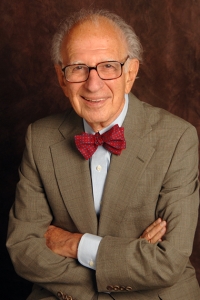Eric Kandel, MD
- Professor Emeritus of Physiology and Cellular Biophysics, Psychiatry, Biochemistry and Neuroscience
- University Professor Emeritus, Sagol Professor Emeritus of Brain Science at the Mortimer B. Zuckerman Mind Brain Behavior Institute

Overview
Eric R. Kandel, M.D., is University Professor at Columbia, Kavli Professor and Director, Kavli Institute for Brain Sciences, and a Senior Investigator at the Howard Hughes Medical Institute.
A graduate of Harvard College and N.Y.U. School of Medicine, Kandel trained in Neurobiology at the NIH and in Psychiatry at Harvard Medical School. He joined the faculty of the College of Physicians and Surgeons at Columbia University in 1974 as the founding director of the Center for Neurobiology and Behavior.
Within the academic community, he is also admired as a teacher. He organized the neuroscience curriculum at Columbia and is an editor of Principles of Neural Science, the standard textbook in the field. He recently has written a book on the brain for the general public entitled In Search of Memory: The Emergence of a New Science of Mind.
Eric Kandel's research has been concerned with the molecular mechanisms of memory storage in Aplysia and mice. Kandel has received twenty-two honorary degrees, is a member of the U.S. National Academy of Sciences as well as the National Science Academies of German and France. He has been recognized with the Albert Lasker Award, the Heineken Award of the Netherlands, the Gairdner Award of Canada, the Wolf Prize of Israel, the National Medal of Science USA and the Nobel Prize for Physiology or Medicine in 2000.
Academic Appointments
- Professor Emeritus of Physiology and Cellular Biophysics, Psychiatry, Biochemistry and Neuroscience
- University Professor Emeritus, Sagol Professor Emeritus of Brain Science at the Mortimer B. Zuckerman Mind Brain Behavior Institute
Gender
- Male
Credentials & Experience
Honors & Awards
- 2000, Nobel Prize in Physiology or Medicine
- Senior Investigator, Howard Hughes Medical Institute
Research
We combine behavioral, cellular, and molecular biological approaches to delineate the changes that underlie simple forms of learning and memory in invertebrates and vertebrates. In invertebrates the focus of our research is on the gill-withdrawal reflex of Aplysia. We study three elementary forms of learning: habituation, sensitization, and classical conditioning. Recently we have reconstituted critical components of this learning in dissociated cell culture, and we now use the reconstituted system to examine the molecular mechanisms which contribute to short- and long-term memory.
In vertebrates we use genetically modified mice to examine the mechanisms of long-term potentiation in the mammalian hippocampus and its relation to spacial memory and maintenance.
Research Interests
- Biophysics
- Ion Channels
- Models of Psychiatric Disorders
- Neurobiology of Learning and Memory
- Neurogenetics
- Synapses and Circuits
- Systems and Circuits
Selected Publications
- Kandel, ER. The New Science of Mind and the Future of Knowledge. (2013) Neuron 80:546-560.
- Pavlopoulos E, Jones S, Kosmidis S, Close M, Kim C, Kovalerchik O, Small SA, Kandel ER. Molecular mechanism for age-related memory loss: the histone-binding protein RbAp48. (2013) Sci Transl Med 5:200ra115.
- Rajasethupathy P, Antonov I, Sheridan R, Frey S, Sander C, Tuschl T, Kandel ER. (2012). A Role for Neuronal piRNAs in the Epigenetic Control of Memory-Related Synaptic Plasticity. Cell 149: 693-707.
- Levine A, Huang Y, Drisaldi B, Griffin EA Jr, Pollak DD, Xu S, Yin D, Schaffran C, Kandel DB, Kandel ER. (2011) Molecular mechanism for a gateway drug: epigenetic changes initiated by nicotine prime gene expression by cocaine. Sci Transl Med 3: 107ra109.
- Choi YB, Li HL, Kassabov SR, Jin I, Puthanveettil SV, Karl KA, Bailey CH, Kandel ER. (2011) Neurexin-neuroligin transsynaptic interaction mediates learning-related synaptic remodeling and long-term facilitation in Aplysia. Neuron 70: 468-481.
- Fiumara F, Fioriti L, Kandel ER, Hendrickson WA. (2010) Essential role of coiled coils for aggregation and activity of Q/N-rich prions and PolyQ proteins. Cell 143: 1121-1135.
- Akil, H., Brenner, S., Kandel, E.R., Kendler, K.S., King, M-C., Scolnick, E., Watson, J.D., and Zoghbi, H.Y. (2010) The future of psychiatric research: Genomes and neural circuits. Science 327:1580-1581.
- Simpson, E.H., Kellendonk, C., and Kandel, E.R. (2010) A possible role for the striatum in the pathogenesis of the cognitive symptoms of schizophrenia. Neuron 65:585-596.
- Si, K., Choi, Y., White-Grindley, E., Majumbar, A., and Kandel, E.R. (2010) Aplysia CPEB can form prion-like multimers in sensory neurons that contribute to long-term facilitation. Cell 140:421-435.
For a complete list of publications, please visit PubMed.gov